Annual Statistical Report on the Social Security Disability Insurance Program, 2000
Charts

In December 2000, about 5.9 million people received disability benefits as disabled workers, disabled widow(er)s, or disabled adult children. The majority (85 percent) are disabled workers, 12 percent are disabled adult children, and 3 percent are disabled widow(er)s.
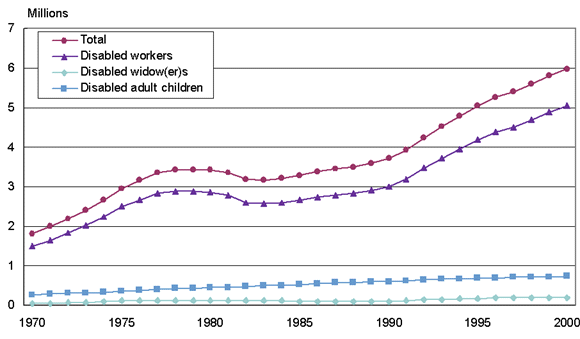
| Year | Total | Disabled workers | Disabled widow(er)s | Disabled adult children |
|---|---|---|---|---|
| 1970 | 1.81 | 1.49 | 0.05 | 0.27 |
| 1971 | 1.99 | 1.65 | 0.06 | 0.29 |
| 1972 | 2.20 | 1.83 | 0.06 | 0.31 |
| 1973 | 2.42 | 2.02 | 0.08 | 0.32 |
| 1974 | 2.67 | 2.24 | 0.09 | 0.34 |
| 1975 | 2.96 | 2.49 | 0.11 | 0.36 |
| 1976 | 3.17 | 2.67 | 0.12 | 0.38 |
| 1977 | 3.37 | 2.84 | 0.13 | 0.40 |
| 1978 | 3.43 | 2.88 | 0.13 | 0.42 |
| 1979 | 3.44 | 2.87 | 0.13 | 0.44 |
| 1980 | 3.44 | 2.86 | 0.13 | 0.45 |
| 1981 | 3.36 | 2.78 | 0.12 | 0.46 |
| 1982 | 3.19 | 2.60 | 0.12 | 0.47 |
| 1983 | 3.17 | 2.57 | 0.11 | 0.49 |
| 1984 | 3.21 | 2.60 | 0.11 | 0.51 |
| 1985 | 3.29 | 2.66 | 0.11 | 0.53 |
| 1986 | 3.38 | 2.73 | 0.11 | 0.55 |
| 1987 | 3.45 | 2.79 | 0.11 | 0.56 |
| 1988 | 3.51 | 2.83 | 0.10 | 0.57 |
| 1989 | 3.58 | 2.90 | 0.10 | 0.59 |
| 1990 | 3.71 | 3.01 | 0.10 | 0.60 |
| 1991 | 3.93 | 3.19 | 0.11 | 0.62 |
| 1992 | 4.24 | 3.47 | 0.13 | 0.64 |
| 1993 | 4.53 | 3.73 | 0.15 | 0.66 |
| 1994 | 4.80 | 3.96 | 0.16 | 0.67 |
| 1995 | 5.04 | 4.19 | 0.17 | 0.69 |
| 1996 | 5.26 | 4.39 | 0.18 | 0.70 |
| 1997 | 5.40 | 4.51 | 0.19 | 0.70 |
| 1998 | 5.61 | 4.70 | 0.19 | 0.71 |
| 1999 | 5.80 | 4.88 | 0.20 | 0.72 |
| 2000 | 5.97 | 5.04 | 0.20 | 0.73 |
The number of disabled workers grew steadily until 1980, declined slightly until 1983, started to increase again in 1984, and began to increase more rapidly beginning in 1990. The changes in growth in the 1980s and 1990s were the result of demographic changes, a recession, and legislative changes. The number of disabled adult children has grown slightly, and the number of disabled widow(er)s has remained fairly level. In 2000, over 5 million disabled workers, 200,000 disabled widow(er)s, and 728,000 disabled adult children received disability benefits.
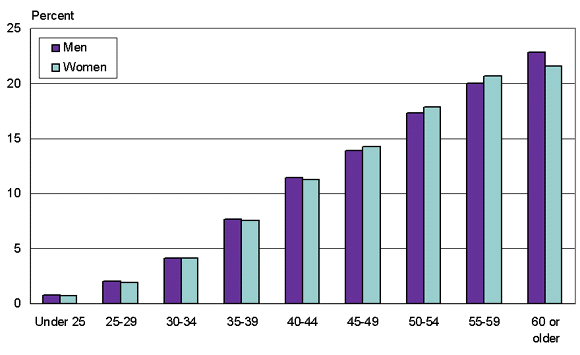
| Age | Men | Women |
|---|---|---|
| Under 25 | 0.8 | 0.7 |
| 25-29 | 2.0 | 2.0 |
| 30-34 | 4.2 | 4.1 |
| 35-39 | 7.6 | 7.5 |
| 40-44 | 11.4 | 11.3 |
| 45-49 | 13.9 | 14.3 |
| 50-54 | 17.3 | 17.9 |
| 55-59 | 19.9 | 20.7 |
| 60 or older | 22.8 | 21.6 |
The percentage of disabled-worker beneficiaries increases with age for both men and women. In December 2000, the largest percentage of disabled-worker beneficiaries are aged 60 or older. Disability benefits convert to retirement benefits when the worker reaches full retirement age, which is age 65–67 depending on the year of birth.
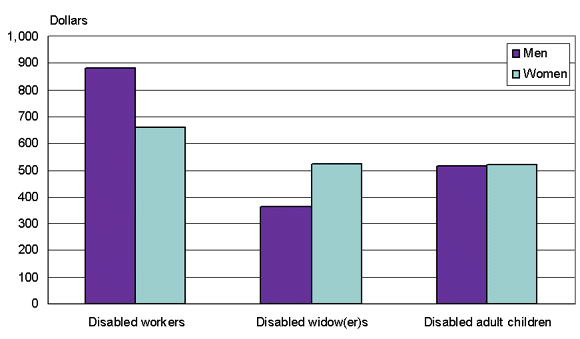
| Beneficiary | Men | Women |
|---|---|---|
| Disabled workers | 882.7 | 660.6 |
| Disabled widow(er)s | 361.7 | 523.8 |
| Disabled adult children | 515.8 | 521.2 |
The average monthly benefit for disabled-worker beneficiaries is higher than that paid to disabled widow(er)s or disabled adult children. The reason for the difference is that disabled workers receive 100 percent of the primary insurance amount (PIA), while disabled widow(er)s typically receive about 71.5 percent of the PIA, and disabled adult children receive 50 percent of the PIA if the worker is disabled or retired or 75 percent of the PIA if the worker is deceased.
Because men have traditionally had higher earnings than women, their monthly benefit is higher. This is most obvious in the disabled-worker group. Disabled widow(er) and disabled adult children benefits are dependents benefits, so their monthly benefit is a function of the worker's earnings. Therefore, a disabled widow's average benefit tends to be higher than that of a disabled widower because the male worker's earnings are higher than a female worker's. The sex of the child is immaterial to the computation of the monthly benefit, so we see little difference between men and women in this group of beneficiaries.
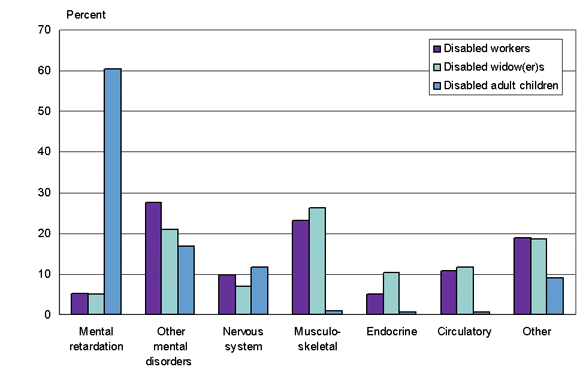
| Diagnostic group | Disabled workers | Disabled widow(er)s | Disabled adult children |
|---|---|---|---|
| Mental retardation | 5.2 | 4.9 | 60.5 |
| Other mental disorders | 27.4 | 21.0 | 16.9 |
| Nervous system | 9.7 | 7.0 | 11.6 |
| Musculoskeletal | 23.2 | 26.2 | 0.8 |
| Endocrine | 4.9 | 10.5 | 0.6 |
| Circulatory | 10.7 | 11.7 | 0.6 |
| Other | 18.8 | 18.6 | 9.0 |
The impairment upon which disability is based varies with the type of beneficiary. In December 2000, other mental disorders is the primary reason disabled workers receive benefits; diseases of the musculoskeletal system is the leading cause of disability among disabled widow(er)s; and mental retardation is the predominant reason for disability among disabled adult children.
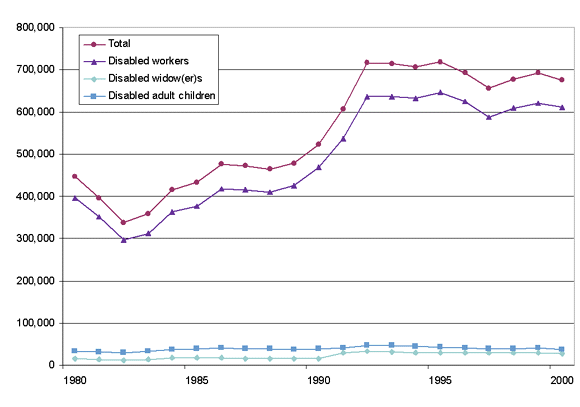
| Year | Total | Disabled workers | Disabled widow(er)s | Disabled adult children |
|---|---|---|---|---|
| 1980 | 446.08 | 397.00 | 16.00 | 33.00 |
| 1981 | 396.55 | 352.00 | 14.00 | 31.00 |
| 1982 | 338.28 | 297.00 | 12.00 | 29.00 |
| 1983 | 359.60 | 312.00 | 14.00 | 34.00 |
| 1984 | 415.59 | 362.00 | 17.00 | 36.00 |
| 1985 | 433.54 | 377.00 | 17.00 | 39.00 |
| 1986 | 475.81 | 417.00 | 18.00 | 41.00 |
| 1987 | 471.91 | 416.00 | 16.00 | 40.00 |
| 1988 | 463.52 | 409.00 | 15.00 | 39.00 |
| 1989 | 477.75 | 426.00 | 15.00 | 37.00 |
| 1990 | 522.17 | 468.00 | 15.00 | 39.00 |
| 1991 | 607.11 | 536.00 | 30.00 | 41.00 |
| 1992 | 716.88 | 637.00 | 33.00 | 47.00 |
| 1993 | 714.32 | 635.00 | 32.00 | 47.00 |
| 1994 | 706.26 | 632.00 | 30.00 | 44.00 |
| 1995 | 718.70 | 646.00 | 30.00 | 43.00 |
| 1996 | 693.53 | 624.00 | 29.00 | 41.00 |
| 1997 | 654.66 | 587.00 | 29.00 | 39.00 |
| 1998 | 677.47 | 608.00 | 29.00 | 40.00 |
| 1989 | 691.89 | 620.00 | 30.00 | 42.00 |
| 2000 | 675.60 | 611.00 | 28.00 | 37.00 |
The total number of awards decreased from 1980 through 1983, started to increase in 1984, and began to increase more rapidly in 1990. Awards for disabled-worker benefits has been most pronounced and drives the overall pattern shown in the total line. Disabled-worker awards increased from a low of 297,131 in 1982, to 636,637 in 1992. Awards to disabled workers have been relatively flat since 1992. There were 610,700 worker awards in 2000. Awards to disabled widow(er)s have increased at a much lower rate than for disabled workers, rising steadily from just over 16,000 in 1980 to 27,600 in 2000. Awards to disabled adult children have remained relatively flat, increasing slightly from 33,470 in 1980 to 37,300 in 2000.
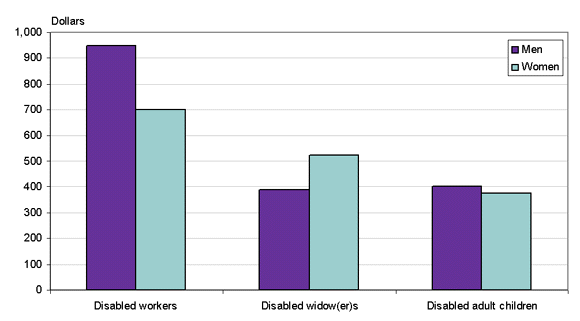
| Beneficiary | Men | Women |
|---|---|---|
| Disabled workers | 947.69 | 700.91 |
| Disabled widow(er)s | 389.50 | 521.41 |
| Disabled adult children | 400.30 | 375.59 |
Average monthly benefits for new awards tend to be higher than those paid to beneficiaries who are already on the rolls (see Chart 4). The exception is payments to newly awarded widows, whose benefits are slightly lower than those paid to widows who were entitled in earlier years.
The average monthly benefit for disabled-worker awards is higher than that awarded to disabled widow(er)s or disabled adult children. The reason for the difference is that disabled workers receive 100 percent of the primary insurance amount (PIA), while disabled widow(er)s typically receive about 71.5 percent of the PIA, and disabled adult children receive 50 percent of the PIA if the worker is disabled or retired or 75 percent of the PIA if the worker is deceased.
Because men have traditionally had higher earnings than women, their monthly benefit is higher. This is most obvious in the disabled-worker group. Disabled widow(er) and disabled adult children benefits are dependents benefits, so their monthly benefit is a function of the worker's earnings. Therefore, a disabled widow's average benefit tends to be higher than that of a disabled widower because the male worker's earnings are higher than a female worker's. The sex of the child is immaterial to the computation of the monthly benefit, so we see little difference between men and women in this group of beneficiaries.
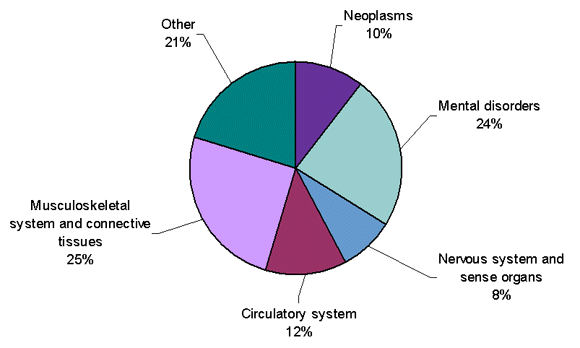
In 2000, 610,700 disabled workers were awarded benefits. The primary impairment for disabled-workers was diseases of the musculoskeletal system and connective tissues (25 percent), 10 percent had neoplasms, 24 percent had mental disorders, 8 percent had a nervous system or sense organ disorder, 12 percent had circulatory problems, and 21 percent had other impairments.
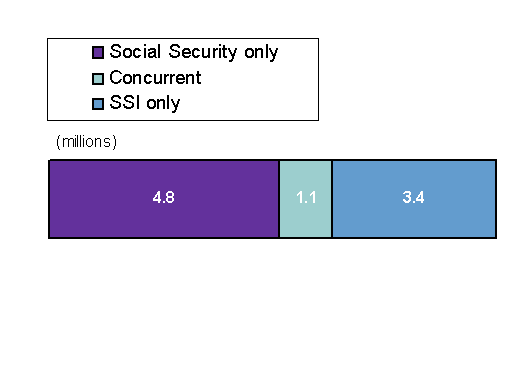
| Type of benefit | Number (thousands) |
|---|---|
| Total | 9,303 |
| Social Security disability | 5,906 |
| Disabled workers | 5,036 |
| Disabled adult children aged 18–64 | 670 |
| Disabled widow(er)s | 200 |
| Social Security disability only | 4,850 |
| SSI disability | 4,453 |
| Blind and disabled aged 18–64 | 3,609 |
| Blind and disabled under age 18 | 844 |
| SSI disability only | 3,397 |
| Both Social Security and SSI | 1,056 |
In December 2000, 9.3 million people under age 65 received benefits on the basis of disability. About 52 percent (4.8 million persons) received benefits from the Social Security program, 37 percent (3.4 million persons) received benefits from SSI only, and 11 percent (1.1 million persons) received benefits from both programs for a total of 9.3 million beneficiaries. This total excludes 63,730 disabled adult children and 721,500 blind and disabled SSI recipients, who are aged 65 or older.
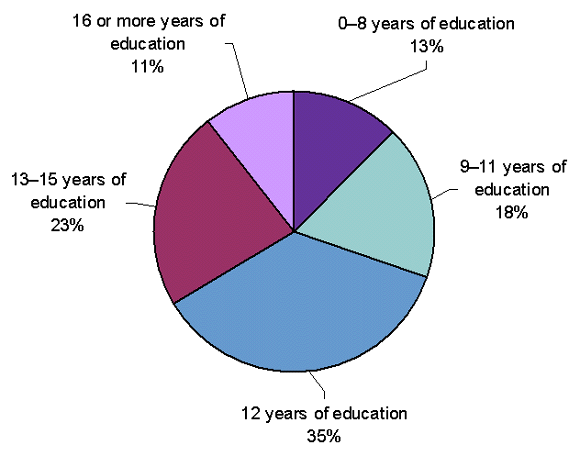
| Education level | Percent |
|---|---|
| 0–8 years of education | 13 |
| 9–11 years of education | 18 |
| 12 years of education | 35 |
| 13–15 years of education | 23 |
| 16 or more years of education | 11 |
Disabled workers have varying levels of education and tend to be less educated than the general U.S. population. More than one-third of the disabled-worker beneficiaries are high school graduates; 13 percent have an eighth grade level of education or less; and 11 percent have a college or postgraduate level of education.

Social Security benefits are the primary source of income for disabled-worker families. Almost half of their income comes from Social Security, while 28 percent comes from family members' earnings, 7 percent comes from Supplemental Security Income, and only 1 percent comes from public assistance.